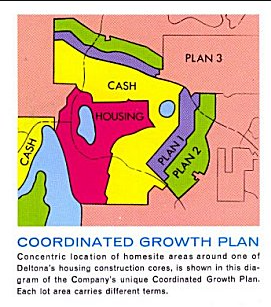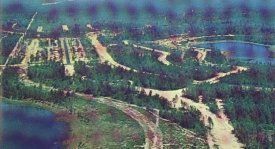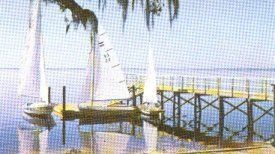THE DELTONA CORPORATION
A NEW BEGINNING
After leaving General late in 1961, the Mackle Brothers began looking for land on which to start a new community - and a new business.
They formed a new corporation - Mackle Brothers. Inc. - a subsidiary of The Mackle Company, Inc. in which the new business would operate.
The Mackle office at 2818 Coral Way, originally built in 1940 had been expanded several times. Adjacent to it at 2880 the Mackles had built a three story addition as headquarters for General Development Corporation. The 2818 property - which would continue in Mackle Company ownership until the late 70s - was either not appropriate or not available for their new venture. So the Mackle Brothers acquired a new site just down the road at the intersection of Coral Way, SW 12th Avenue and the diagonal SW 3rd Avenue - an intersection known as "Five Points". It was there that the headquarters for the new venture would be located for the next twenty five years.
Within a very short time they focused on a beautiful tract of land in northeast Florida. The land was located about midway between Orlando and Daytona Beach in Voluscia County. The nearest town was Deland. In this heavily wooded lake country they put together approximately 15,000 acres of land and named it Deltona Lakes.
The activity at Cape Canaveral and the growth of that area since the late 50's had attracted their attention. However, Orlando was still a sleepy little central Florida town. The plans for Disney World would not be announced for several years and would not be open until 1971. The Interstate Highway - I-4 - was just being completed.
But the vision of the Mackle Brothers was as clear as ever.
The name Deltona was created by combining parts of Deland and Daytona.
Early marketing plans referred to this area of Florida as the "Golden Triangle" (Daytona - Orlando - Cape Canaveral) and the "Land of Three Seasons". This was - by far - the farthest north that any major community developer had gone. The cooler north Florida climate was an issue - for south Floridians anyway!
In those days developers were welcomed with opened arms and permitting was minimal.
Dad believed - as a matter of faith - that people all over the world dreamed of living, recreating and retiring in the Sunshine State.
There would be an early test of that faith!
Three weeks before the scheduled opening of Deltona Lakes, on October 22, 1962, John F. Kennedy went public with the news of the Cuban Missile Crisis.
In the weeks preceding the opening - with national advertising about to be launched - Florida was virtually on a "war alert".
Military vehicles were everywhere on the streets of South Florida. The national press was focusing on the dramatic military preparations in Florida and on Florida's proximity to Cuba. Even the Mackle Brothers were alarmed enough to begin construction of a fall-out shelter at their farm in Lake Placid.
In addition to the personal concern for themselves and their families the Mackles new venture - always a risky undertaking - was seriously threatened. As devastating as it must have been at the time ...to the building of a new sales force ... to the sales presentations that were starting to be made ... to the discussions of the merger with C.K.P. that were under way... to the attitude of their banks... the opening went ahead as scheduled and the potential setback was weathered.
And, while it was mentioned occasionally in later years, what could have been a fatal blow to someone else was just one small speed bump on the road to the Mackle Brothers success.
The community of Deltona Lakes opened on November 18, 1962 just ten months after the Mackle had left General Development.
The Deltona Lakes property is located 8 miles from DeLand, the county seat of Voluscia county and home of Stetson University. It is midway between Orlando and Daytona Beach fronting on Interstate Highway 4. The land exhibits contour from 20 to 112 feet above sea level. Deltona Lakes is blanketed by pine and spreading oak trees and is sprinkled with more than 30 lakes of varying size. The city fronts on Lake Monroe, a part of the St. John's river chain, and is served by a vast deep reservoir of pure drinking water.
Deltona Lakes set the pattern for the later Deltona master planned communities. On the acreage the Mackle Brothers planned an new Florida City. Sites for government facilities, shopping centers were included in the master plan. Office sites, post office sites, sites of worship, elementary, middle and high school sites, golf courses, recreation areas, parks, arterial roadways and secondary streets and, of course, home sites were carefully laid out - in state-of-the-art fashion - by Jimmy Vensel and his staff. The streets were curvilinear - hardly a straight street was designed - and were individually named - a huge task in a community of a "thousand" streets. Of course - as in virtually every Mackle community - one of the main thoroughfares was named "Elkcam Boulevard."
The project opened with eight model homes, one long winding road and a sales office at the entrance - nothing more.
And - in spite of the concerns of the Cuban Missile Crises - sales were outstanding. In the first full year of 1963 over ten million dollars in land and homes sales were made, a record for any Mackle community to date!
During that short time a great many other things - necessary to the launching of a new venture and a new community - were being accomplished. An organization was being put together. An international sales force was being built from the ground up. Sources of bank financing were being arranged.
But to build the company they wanted to build would require public financing.
C.K.P Developments, Inc. had been formed as a Delaware company earlier in 1962 to acquire the assets of C.K.P. Developments, Ltd., a Canadian firm which had done business for years under the name of Cockshutt Farm Equipment Ltd.
Cockshutt, in 1961 had acquired the assets of N. K. Winston-Sanson Florida Developments Corp. In January of 1962 it had sold its farm equipment division to White Motor company. They also owned a company called Brantford Coach and Body Works, a manufacturer of truck and trailer bodies, which they were offering for sale.
C.K.P. Developments, Inc. was listed on the American Stock Exchange. With the sale if its other operations it was essentially a company in transition. They had started three projects, a 400 acre subdivision, Winston Park, in Daytona, Mount Plymouth, a subdivision on the north side of Orange County and a garden apartment project, Lake Maitland Terrace, in Maitland, on the edge of Orlando. They also owned a small utility operation called Seaboard in the Tampa area. Their other assets were in the form of cash and two large parcels of land, one, a 6,600 acre tract outside of Tampa and another, a 14,350 acre parcel, outside of Orlando. In the early days and for many years after the merger these two larger parcels were considered to be of poor quality for development. Each included a high percentage of swampland and poor sub-soil conditions. Over the next twenty years - as the cities of Orlando and Tampa grew out to these properties - they eventually became valuable land assets.
C.K.P. - like Florida Canada eight years earlier - was a public company with some land assets, a lot of cash and no significant operating entity.
The main attraction of the merger was C.K.P.'s cash reserve and its listing on the American Stock Exchange which would give them access to the capital they needed to grow the company.
After the merger, Winston Park, Mount Plymouth and the Lake Maitland Terrace and Seaboard Utility would be quickly completed or disposed of as not fitting in to the Mackle plans. The two larger parcels would be set aside for "future development".
On December 18, 1962 the Wall Street Journal reported that C.K.P. had acquired the stock of Mackle Brothers, Inc. for "about 3.5 million". The Mackles received 250,000 shares of C.K.P. for 14.25 per share or$3,562,500. The Journal said that there were 1,079,595 shares of CKP outstanding. The issuance of stock to the Mackles brought the outstanding share total to 1,329,595. The Mackle Brothers were now the owners of 18.8% of the public company.
The three Mackle Brothers would become the principal officers and manage the company. Norman K. Winston retained the title of Chairman of the Board.
By July 1963, so much advertising was being done and so much press attention was being garnered for the new Deltona Lakes community that the Board voted to change the name of the company to from C.K.P. Development, Inc. to The Deltona Corporation.
So less than a year after leaving General Development the Mackles were back, with a new public company and with a beautiful new community.
They were off and running!... again!
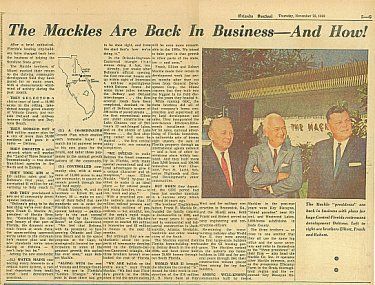
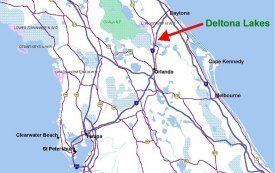

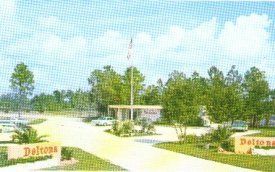
Deltona Lakes Entrance
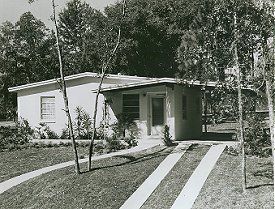
Model Home
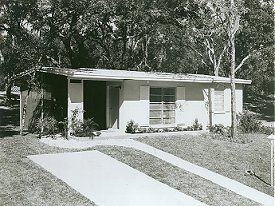
Model Home
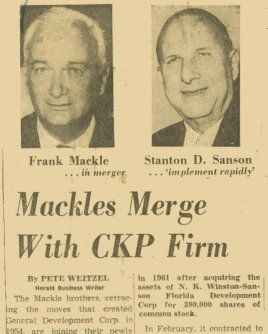
THE DELTONA CORPORATION
Deltona was organized along lines similar to those that had proven successful at General Development.
The three key executives at General - along with many others - had come over to the Mackles new company.
They were Neil Bahr head of Marketing, Bill O’Dowd head of Corporate Finance and Construction and Jim Vensel head of Architecture and Engineering.
The marketing operation had to be rebuilt from scratch. Soon Neil had established a new network of branch and franchised offices covering the east, the southeast and the midwest parts of the country. At Deltona there would be a much bigger "off-shore" organization as well.
Chartered trip programs, lot control, annual sales conventions, regional sales managers, sales training, national and international advertising were all improved versions of the General experience.
Bill O'Dowd organized a new Construction and Development department bringing in Earle Cortright Sr. - a long-time South Florida builder - to manage it. Those activities would now be done in house - instead of under a separate contract - but except for the fact that their paychecks came from Deltona Corporation and not from The Mackle Company the setup was the same with central control in the Miami office and Project Mangers at each jobsite.
Dad and Bill O'Dowd renewed bank relationships with First National Bank of Miami and with Bank Boston.
Jim Vensel directed the new land planning projects and recruited Art Day to supervise all engineering. Jim Vensel soon brought in noted Miami architect, Herbert Rosser Savage, to head up his architectural design department.
Much was learned from their experience at GDC.
It had - from the start - been the Mackle Brothers intention to build communities - not just sell land.
The success of the installment land sales business was vital to the early financial success of the company.
But building and construction was their history, their tradition, their success to date and - most importantly - the goal for both General Development and The Deltona Corporation from the start.
Dad would include a reminder of that fact each spring in his Letter to Stockholders in the company's Annual Report.
It was expected and intended, as evidenced by many of the early speeches as well as much of their advertising that - from a business standpoint - "land sales" - as lucrative as they were - would only set the stage for a major home building program in the future.
Assessing the General Development experience and - not surprisingly - to compete with them more effectively, the Mackles implemented several new community development concepts.
At General "bigger was better". Port Charlotte, for example, was envisioned as a community of 92,700 acres, well over 200,000 home sites and and an ultimate population of perhaps 500,000 or more!
It could already be seen that there was downside to that size of community. A property like Port Charlotte was so large that the company would still be selling lots when the first contracts were being deeded. Their own customers - who bought at much lower prices - would be their main competition.
Also - at General Development communities - there had been no central water systems at first. It was considered routine at the time for water to come from individual wells.
And - as the installment land business was just being invented - there had been little or no coordination between the land development activities and the sales department. Decisions on release of areas for sale were not planned in advance. The various contract completion dates - one, two, five or ten years - were not well planned.
These and other factors resulted in the introduction of The Three Mackle Firsts to be applied to all future communities.
These were new concepts designed to create better communities as well as to give Deltona a competitive advantage over General and other Florida developers.
Every community would have:
1. A Coordinated Growth Plan
Communities were to be planned so that different sales plans would create orderly development and a smooth community growth pattern. At the center (and there usually were two or three centers within a community) was the housing area in which only house and lot packages would be sold. Then in concentric circles outside of the housing core would be a cash lot sales area then the one year installment plan lots then the two year plan and so forth up to eight and a half years.
2. Limited Size
No longer would the Mackles seek mammoth property acquisitions. Communities would be limited to 15,000 acres. This would allow the company to sell out a community before most of the lots were deeded. The customer and the company benefited. When customers were given a deed and some of them went on the resale market they would not be in competition with the company. Also, as the project was completed, there would be a limited supply to meet the demand for lots on resale.
3. A Central Water System to Every Lot.
The customer would be assured of unlimited treated water supply. And the company would create a new and continuing source of revenue.
These "firsts" were tangible evidence to their commitment to the long term good of a community, to creating - ultimately - a secondary market demand for the land which they sold and to putting more "value" into the property they were selling.
Another significant change was the nature of the property they would acquire.
At General, property in the southern part of the state - in massive amounts - were sought. South Florida, while blessed with beautiful beaches and rivers is mostly flat pine land just a few feet above sea level. And that was the character of all the General Development communities.
As the Mackles moved north they were attracted to the beautiful rolling wooded and lake dotted lands of central and north Florida.
Deltona Lakes was a good example. Clear fresh water lakes abounded on the Deltona Lakes property. Oaks - some many years old - and pines covered the 15,000 acres. The property fronted on Lake Monroe which itself was in the St. John's river chain - one of the most beautiful rivers in Florida. Lined with over hanging moss covered oak trees the St. John's travels from lake Monroe north to empty into the Atlantic at Jacksonville. A boat trip along the St. Johns from Lake Monroe to the Atlantic offers scenery, fishing and water sports unequaled anywhere.
Voluscia County, like all of central Florida, is blessed with an abundant supply of crystal clear drinking water. from deep under ground aquifers that rise to the surface every so often forming such scenic wonders as Silver Springs and Wekee Wachee Springs.
All of the "Three Seasons Communities" began with similar attributes.
So - some things old and some things new.
An exciting new chapter in the Mackle family story was under way.
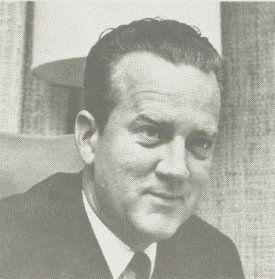
Neil Bahr
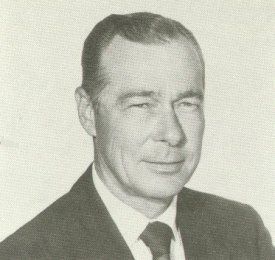
Bill O'Dowd
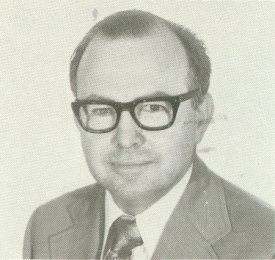
Jim Vensel
